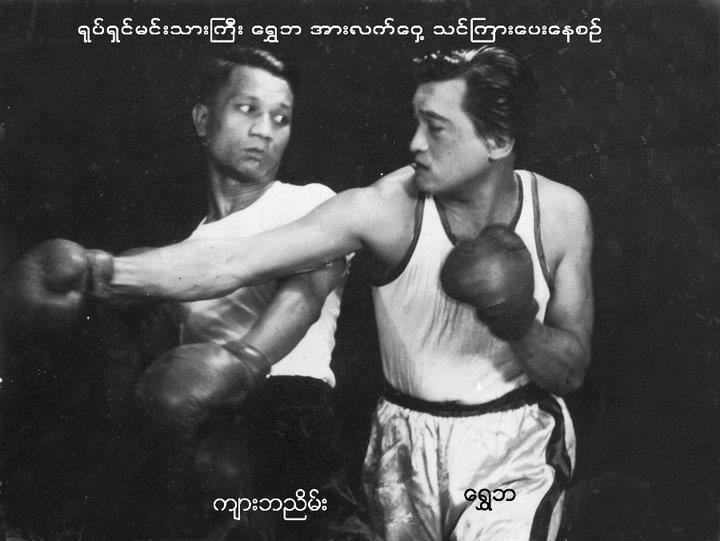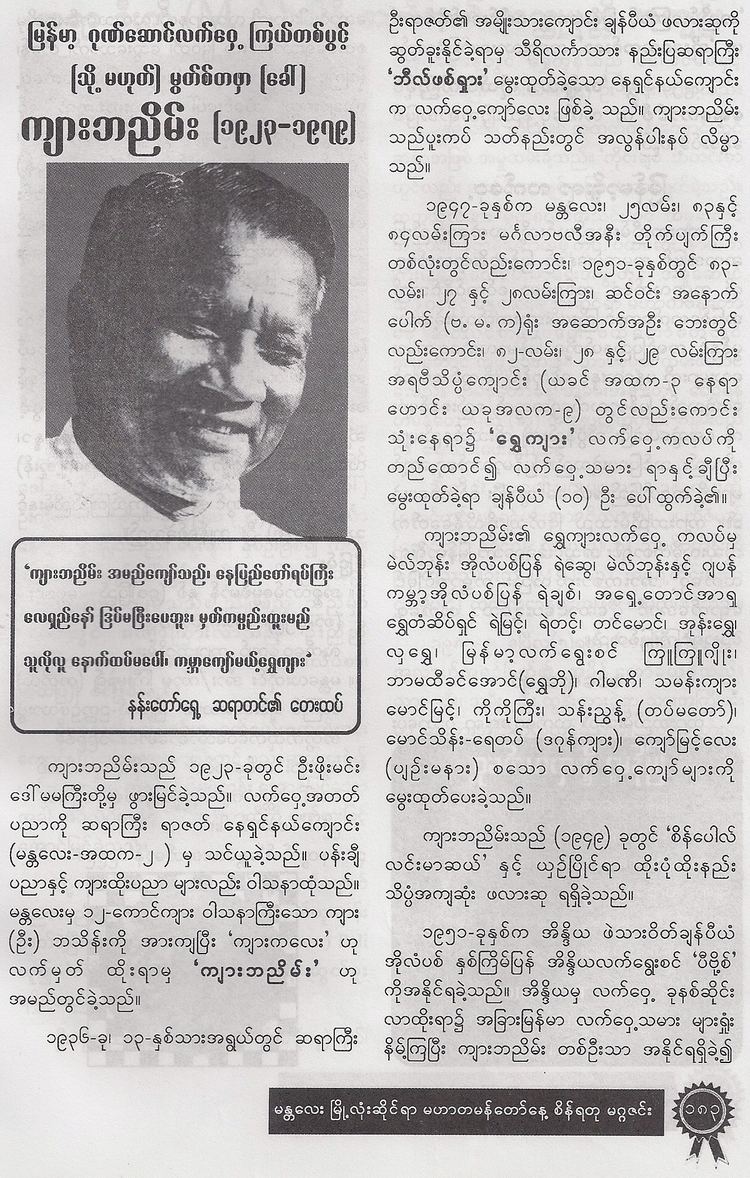Nickname(s) Kyar (Tiger) Name Kyar Nyein Rated at Heavyweight Role Boxer | Nationality Burmese Height 1.63 m Total fights ~50 Division Heavyweight | |
 | ||
Born 23 November 1923Mandalay, British Burma ( 1923-11-23 ) Died July 8, 1979, Yangon, Myanmar (Burma) | ||
"Kyar" Ba Nyein (Burmese: ကျား ဘငြိမ်း [tɕá ba̰ ɲéɪɴ]; 23 November 1923 – 8 July 1979) was the Burmese boxer who participated in boxing at the 1952 Summer Olympics and was a pioneer in modernizing the Lethwei, or Burmese style of traditional boxing. Ba Nyein started boxing at the age of 13 and fought in about 50 matches over 20 years until retiring from fighting at the age of 33.
Contents
- Education
- After the Second World War
- Achievements
- Sports Reporter Painter Author and Journalist
- Voluntary works and training young boxers
- Lethwei or Burmese traditional boxing
- References

Education
Born in 1923, Ba Nyein's official height was listed at 5 ft. 4 inches, weighing in at 120 lbs. He and his wife, Kyi Kyi, had 10 children by the time Ba Nyein was 40. Ba Nyein (Mohammad Mustafa) studied at Wesleyan School (BEHS 16 Mandalay) and later transferred to SPG (the Society for the Propagation of the Gospel) in Foreign Parts' Royal diocesan high school (No. 10 BEHS Mandalay) for a few years.
Lastly, he studied at the Mandalay National High School (present day BEHS 2 Mandalay), where he started learning boxing. He was trained by Sinhalese Anglo-Burman Bill Fisher. In 1947, he trained with the famous boxer Than Yin, a Mandalay Police Officer, who received the best boxer award given by world heavyweight champion Gene Tunney in Sri Lanka. Ba Nyein learned his famous "infighting" from Than Yin. In 1936, he became National School Cup Champion at 13. During the Second World War, he left school.
After the Second World War
After the war, Nyein painted for a living with the Allied soldiers. He was the champion of the Kyar-Hto game, which is a Burmese variant of the board game Draughts. He got his nickname "Kyar" (Tiger) from the famous Burmese Draughts player in Mandalay, Ba Than Gyi (known as "Kyar" Ba Than Gyi) who taught him the tactics and strategy of the game. He soon adopted the nickname "Kyar Kalay" (Little Tiger). In the 1974 boxing tournament, he won the Bantamweight class and became Champion, and newspapers started to call him Kyar Kalay Ba Nyein. This was later changed to Kyar Ba Nyein. When he established the Golden tiger boxing club, his ring name was firmly established as Kyar Ba Nyein.
Achievements
Ba Nyein was awarded “The best boxer who used scientific techniques” award in 1949. (He competed with Min Kywe, Samuel from St. Paul, Ki White and Saw Hadi). His best known match occurred in 1951 with the Indian featherweight Champion P. Bose. The Indian team won six matches against Burmese contenders, but Kyar Ba Nyein bested the Indian in that match. P. Bose, who Kyar Ba Nyein defeated, was India’s best featherweight champion and was selected to represent India twice in the previous Olympics. Because of this, Kyar Ba Nyein was selected to compete on behalf of Burma in the 15th Olympics held in Helsinki, Finland, in 1952. Ba Nyein was sent to Bangkok for International Boxing Association's Referee examination.
Sports Reporter, Painter, Author and Journalist
Ba Nyein started as a volunteer Sports Reporter for the 'Ludu' newspaper and the 'Ludu Journal', following his younger brother Ba Thein, who was already a reporter at that newspaper.
His numerous articles, stories on World Boxing matches, news reports, and sports news commentaries were later published regularly in magazines and journals such as: Myawaddy, Thwe Thauk (Comrade), Mogyo (Thunder) and Tagun (Banner). His first book published was, “Blood on the sand”.
Voluntary works and training young boxers
He was the first Burmese to train youths on the street. He established Golden Tiger Boxing clubs in Dah dan 25th street and another near the Burma Muslim Congress on 83rd street. He trained hundreds of young boxers, and was appointed a boxing trainer in 1954 by the National Fitness Council. Ye Chit, Ye Swe, Ye Myint and Ye Tint were the boxers he trained from Mandalay. Tint Tun, Alexandria and Hla Shwe (Navy) from Rangoon were also his trainees. Kyar Ba Nyein was so proud about the success of his boxers that he once told Ludu Daw Ah Mar that he never got serious injuries or scars during his 50 boxing matches, including seven with foreigners. But he got multiple scars, while training his boxers, because he allowed his trainees to hit him during training sessions, to teach in a practical way: how to fight back without retreating to avoid the opponent’s assault.
Lethwei or Burmese traditional boxing
He was a pioneer, who drew up the modern scientific rules and regulations that have been used since 1953 for Burmese traditional boxing, or Lethwei. He went around all of Burma, especially up to the Mon and Karen states, near Thailand, where there are a lot of villagers active in Burmese traditional boxing or Lethwei. He brought them back to Mandalay and Rangoon, trained them with the new scientific methods and encouraged them to fight in the Burmese traditional boxing matches, which he had organized around the country and even once, in October 1960, to Beijing and Shanghai, China where he led about 100 boxers to show Burmese traditional boxing, or Lethwei, at the signing ceremony of the Burma-China border treaty. At that time the group leader of the Burmese delegation was Lieutenant Colonel Aung Gyi.
He also organized goodwill matches by leading a group of Burmese traditional boxers to Thailand.
Kyar Ba Nyein died in 1979 suffering from rectal cancer.
